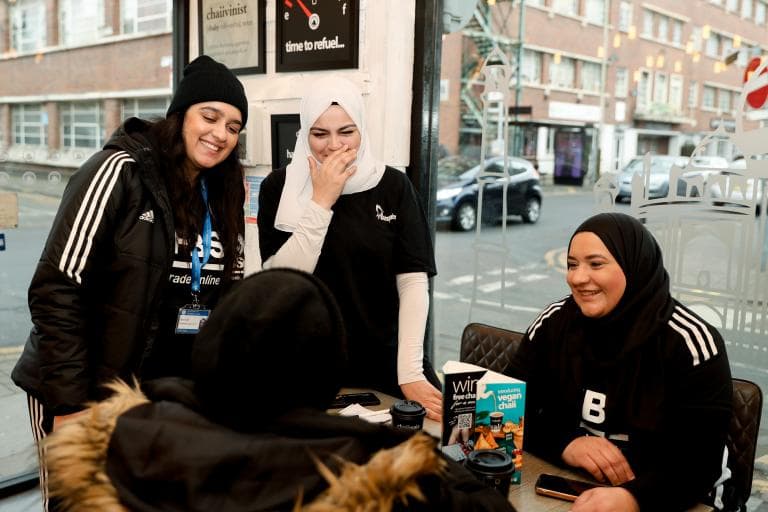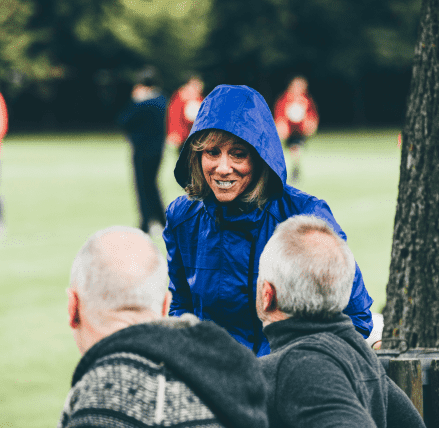Toolkit
Stage 3
Making connections

Co-designed defined
Co-design is the process of actively involving stakeholders in the development and design of your project.
For example, timing and level of activities, equipment needs, publicity methods, coach backgrounds and training and costs.
By talking to potential participants, you can start to understand what’s holding them back from participating, and what’s motivating them to get involved. For example women may be deterred from attending if the facility or the area around a facility doesn’t feel safe, so you may consider lighting the approach to your facility as well as other safety measures.

Doing it right!
This section provides guidance on engaging with local people and organisations to co-design and develop your project. This key stage allows your local community to tell you about their lives and how they hope to take part in sport and activity.
Engagement with local communities should be conversational, informal and involve you asking open questions and listening, establishing relationships and trust. This will help you find out about their lives and motivations and the barriers they face to getting active.
This section offers some tips on engaging with new audiences and partners.
Community engagement tips
- People like me. Choose individuals or local organisations to lead the engagement with relationships or connections to your target audience.
- Don’t over-engage. Some groups are approached by a number of organisations, so check whether engagement has already taken place. You can use existing sources of community engagement to inform your project.
- Trusted individuals. Engage with local community leaders and influencers who represent the community and can help you engage with them.
- Meet people where they are. Go to their local area to meet in a place and at a time that works for them.
- Communication. Engage with your target audience in their own language, with the help of a translator if necessary and offer full access to engagement for people with disabilities. Identify partners that may be able to support you with this.
- Keep your conversations welcoming and relaxed. Be friendly and get to know people, then find out about their relationship with sport and activity. Keep things simple and avoid using jargon.
- Be curious and open. Show an interest in the people and communities that you are talking to, as this can go a long way towards building trust and understanding. Make sure you are prepared to follow the conversation and listen, rather than going into a conversation with an agenda.
- Don’t make assumptions, generalise or have preconceptions. Don’t assume you understand someone’s life, experiences or needs.
- Building relationships takes time. People have busy lives, and some may have had negative experiences in the past.
- Multi-sports opportunities. Although the Foundation’s investment is football-led, other sports or activities may be more popular with your audiences.
- Keep everyone updated. Share the findings of your engagement with your partners and keep them informed of your progress.
- Workforce and volunteer development. Recruit team members and volunteers with experience working in those communities or prior community development work. Seek out or provide training to help people gain the skills needed to deliver effective community engagement initiatives.
- Don’t over-promise. Be honest about what the project can achieve and likelihood of delivery.
- Face-to-face, conversational, informal engagement with space to talk about wider issues, will offer the best results. Relying on a survey or a one-off focus group will often not give you a full or rounded picture and may only engage people who are already supportive of your project, rather than helping you to reach new audiences.
Open questions – case study from Derby:
Here are some examples of open engagement questions developed by Derby PlayZones Consortium. Remember this is not an exhaustive list. These questions were developed for a specific project and a specific target audience. When you are preparing for your conversations, try not to be too prescriptive, just let the conversation flow:
Our engagement approach explores the movements and routines that people follow and their associations within their community.
- How do they spend their time?
- How do they move around?
- Who do they connect with?
We also wanted to hear about their personal perceptions of life in ‘place’ – what works and what doesn’t?
- What’s hard to live with and what do they enjoy?
- And finally, their aspirations – what do they want for themselves and their community?
All of this will help us to build a picture of what it is like to live and be active in Derby's communities.

Capturing your engagement
Always take note of the people you speak to as well as key points from your conversations. This will inform the design and delivery of your project and evidence community needs and wants. We have created a community engagement log to support this important task.